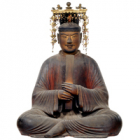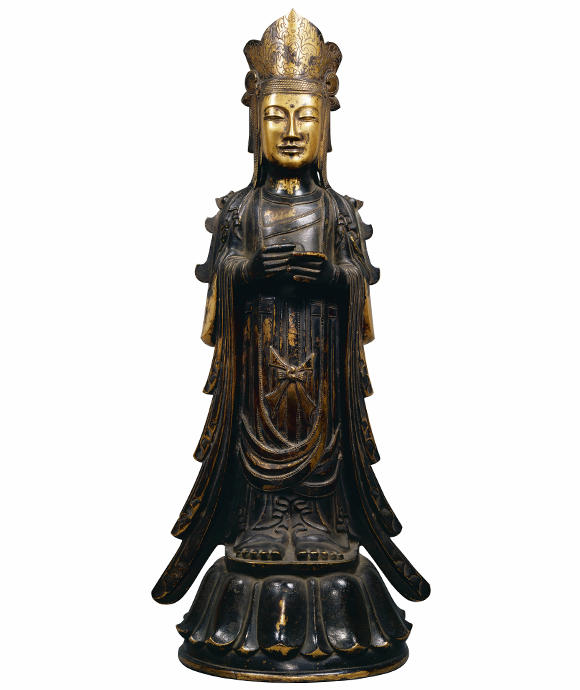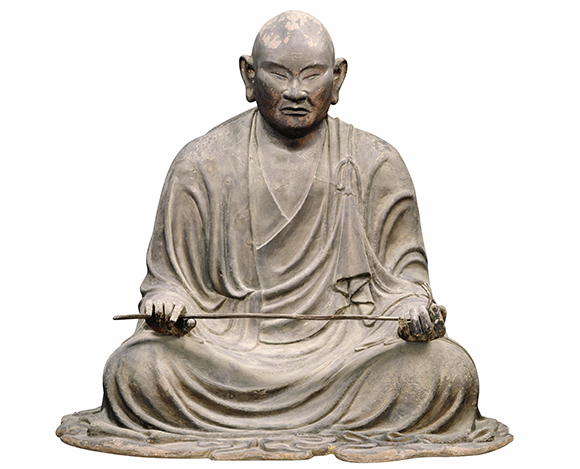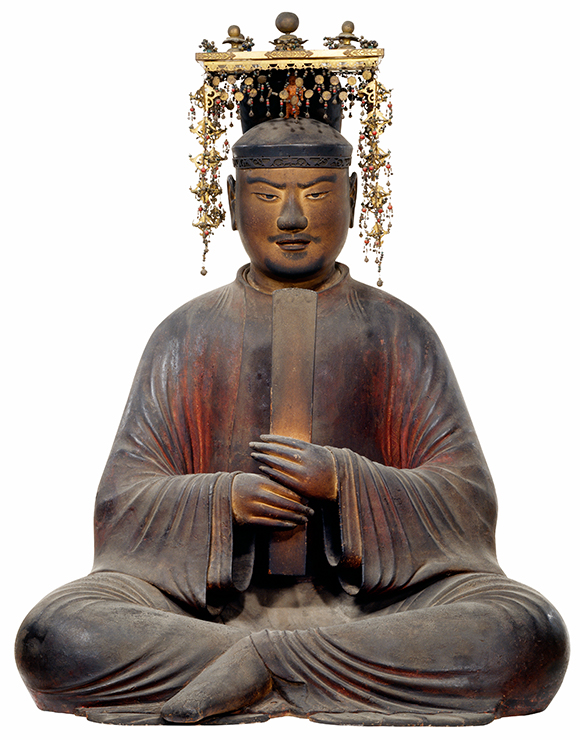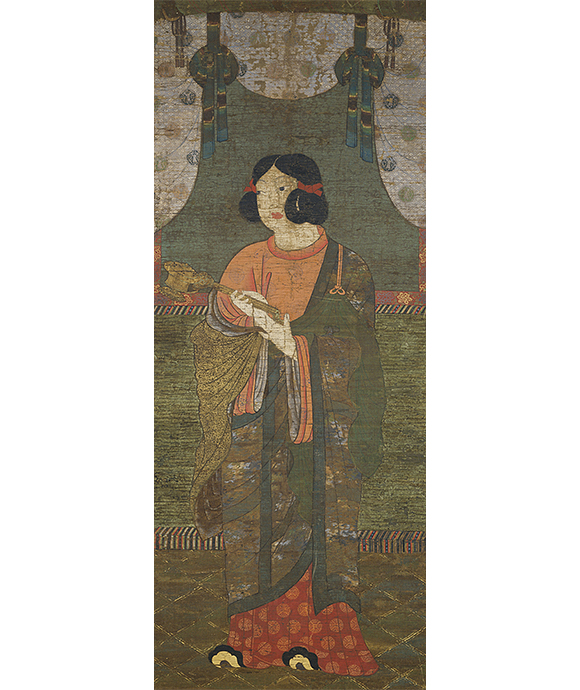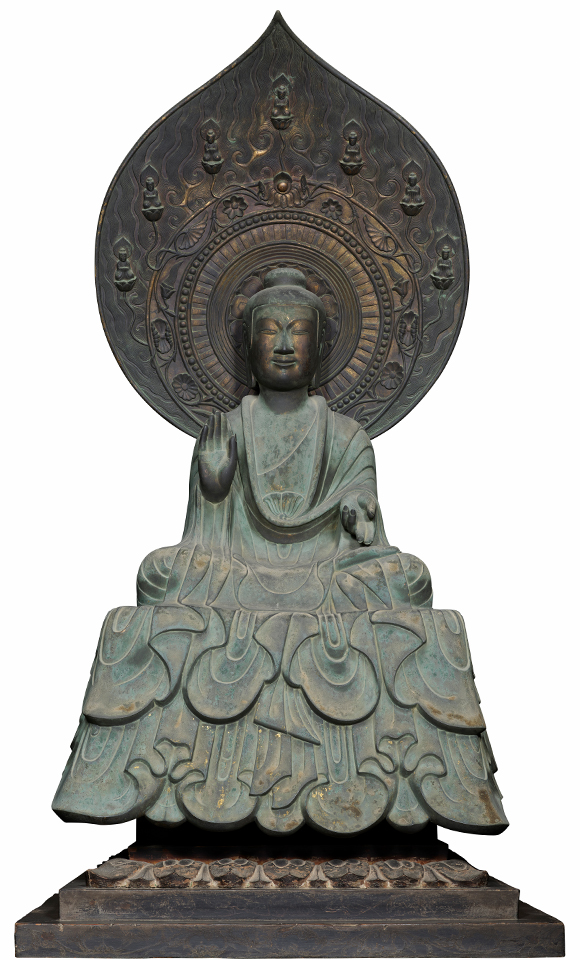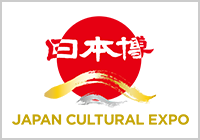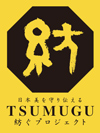Highlights of the Exhibition
Prince Shōtoku and the Flowering of the Buddha Dharma
The Chronicles of Japan (Nihon Shoki, 720) and other sources tell us that Buddhism was officially transmitted to the Japanese archipelago from the Korean kingdom of Baekje, either in 538 or 552, during the reign of Prince Shōtoku’s (574–622) grandfather Emperor Kinmei (509–571; r. 539?–571?).
The early reception of Buddhism in Japan engendered great unrest, at the center of which was a conflict between the pro-Buddhist Soga clan and the anti-Buddhist Mononobe clan. As Shōtoku rose to the position of Prince Regnant, the impact of his patronage expanded with his ascendant political power. Buddhism became increasingly enmeshed at court and within elite society.
In this section, we delve into the earliest period of Japanese Buddhism, focusing on Shōtoku’s scriptural commentary to rediscover the historical figure of the prince, here contextualized in the material culture of his world.
|
|
|
Standing Bodhisattva
Asuka period, 7th century, Hōryūji Temple, Nara (Important Cultural Property)
|
The Establishment of Hōryūji Temple
Prince Shōtoku (574–622) established the temple Ikarugadera, which would become Hōryūji Temple, to the west of his Ikaruga Palace residence in 607. That same year, Shōtoku dispatched Ono no Imoko (dates unknown) to China as an envoy to the Sui dynasty (581−618). The construction of Hōryūji took place in the midst of a major historical turning point that began with Shōtoku’s 603 reorganization of court ranks into twelve tiers in accordance with continental models. The temple’s name evokes the capital’s transformation into a Buddhist land: “Hōryū” abbreviates “Buppō kōryū,” a phrase that declares the expansion of the flourishing Buddhist Dharma.
In this section, we present an exquisite collection of Buddhist implements and other ritual objects as we introduce the magnificent Buddhist adornments of Hōryūji.
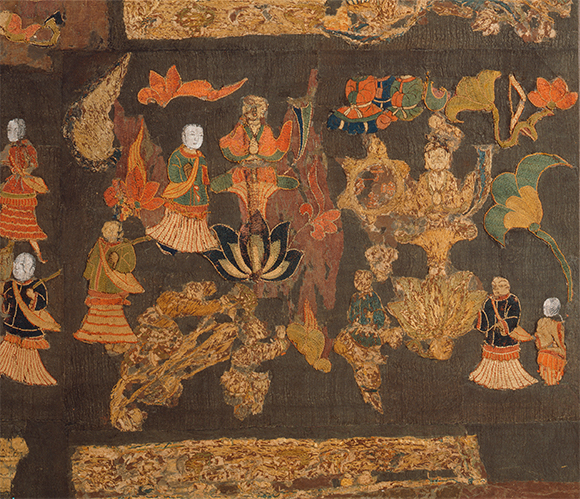 (detail) (detail)The Land of Heavenly Longevity (Tenjukoku) Embroidery
Asuka period, ca. 622 (Suiko 30), Chūgūji Temple, Nara (National Treasure)
On view during the first rotation: July 13 – August 9, 2021
|
Treasures of the Eastern Precinct at Hōryūji Temple
The Eastern Precinct of Hōryūji Temple is built on the grounds of the former residence of Prince Shōtoku (574–622), Ikaruga Palace. We learn from the Record of the Founding and Property Assets of the Hōryūji Eastern Precinct (On view in the second rotation) that the monk Gyōshin appealed to Imperial Princess Abe (718–770; r. 749–758 as Empress Kōken), asking to transform the ruins into the Eastern Precinct, resulting in its construction in 739.
Beginning in the Heian period, Shōtoku came to be venerated as the emanation of a Buddhist deity, and the Eastern Precinct emerged as the heart of the Shōtoku cult at Hōryūji. In this section, we turn our focus to this precinct that played such a key role in the efflorescence of faith in Shōtoku. Just beyond the Hall of Dreams, The Illustrated Biography of Prince Shōtoku and the “Homage to Buddha” Relics were enshrined in the Painting Hall (Eden) and the Relics Hall (Shariden) respectively. These objects of great sacred significance inspired ever more widespread faith in Prince Shōtoku. We will also focus on the splendorous rituals performed in the Eastern Precinct, such as the Shōryō-e, a Buddhist ceremony praising and memorializing Shōtoku’s virtues, and the Daieshiki, a ceremony conducted only once every ten years on the anniversary of his passing.
|
|
Seated Portrait of Priest Gyōshin, Second of the Sōkan Ranks
Nara period, 8th century, Hōryūji Temple, Nara (National Treasure)
|
|
|
The Sacred Forms of Prince Shōtoku
In the Heian period (794–1192), Shōtoku came to be understood as an emanation of the bodhisattva Kannon (Avalokiteśvara); he soon became widely known and worshipped as such. The portrait enshrined in the Shōryōin at Hōryūji, Prince Shōtoku and Attendants was created to commemorate the 500th anniversary of his death. It exemplifies this stage in Shōtoku faith, both stylistically and as one of the prince’s several iconographic depictions that reflect contemporaneous beliefs about him. The visual vocabulary for representing Shōtoku expanded to be richer and more diverse than that representing any other religious founder or patriarch in Japan, encompassing depictions of the prince at age two, at age sixteen, and at several other episodes in his life.
This section of the exhibition introduces masterworks of painting from Hōryūji and a selection of images that epitomize the enormous breadth of Shōtoku’s representations.
|
|
|
Seated Prince Shōtoku
Heian period, 1121 (Hōan 2) , Hōryūji Temple, Nara (National Treasure)
|
|
|
Filial Prince Shōtoku (Kyōyō zō)
Kamakura period, 13th century, Hōryūji Temple, Nara (Important Cultural Property)
On view during the second rotation: August 11–September 5, 2021
|
|
|
The Hōryūji Golden Hall and Five-Storied Pagoda
According to the Chronicles of Japan (Nihon shoki, 720), the Wakakusa Precinct established by Prince Shōtoku (574–622) burned to the ground in 670. Later, the Western Precinct (Saiin Garan) was reconstructed. The Golden Hall (Kondō) is the oldest extant wooden structure in the world, and its inner sanctum survived into the twentieth century without any major changes. On the first level of Hōryūji’s Five-Storied Pagoda (Gojūnotō), large groups of clay sculptures Nos. 194 to 207 are arranged in dioramas depicting important scriptural episodes. These works are known for their great pathos and haunting naturalism.
In this final section of the exhibition, we introduce the Golden Hall and the Five-Storied Pagoda through an array of masterworks representing the attainments of Asuka-period Buddhist art.
|
|
|
Seated Yakushi (Skt. Bhaiṣajyaguru)
Asuka period, 7th century, Hōryūji Temple, Nara (National Treasure)
|
![]() List of Works (576KB)
List of Works (576KB)![]()

